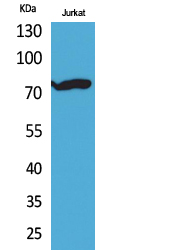p73 (Acetyl Lys327) Polyclonal Antibody
- Catalog No.:YK0038
- Applications:WB;ELISA
- Reactivity:Human;Mouse;Rat
- Target:
- p73
- Gene Name:
- TP73
- Protein Name:
- Tumor protein p73
- Human Gene Id:
- 7161
- Human Swiss Prot No:
- O15350
- Mouse Gene Id:
- 22062
- Mouse Swiss Prot No:
- Q9JJP2
- Immunogen:
- The antiserum was produced against synthesized Acetyl-peptide derived from human p73 around the Acetylation site of Lys327. AA range:291-340
- Specificity:
- Acetyl-p73 (K327) Polyclonal Antibody detects endogenous levels of p73 protein only when acetylated at K327.
- Formulation:
- Liquid in PBS containing 50% glycerol, 0.5% BSA and 0.02% sodium azide.
- Source:
- Polyclonal, Rabbit,IgG
- Dilution:
- WB 1:500 - 1:2000. ELISA: 1:20000. Not yet tested in other applications.
- Purification:
- The antibody was affinity-purified from rabbit antiserum by affinity-chromatography using epitope-specific immunogen.
- Concentration:
- 1 mg/ml
- Storage Stability:
- -15°C to -25°C/1 year(Do not lower than -25°C)
- Other Name:
- TP73;P73;Tumor protein p73;p53-like transcription factor;p53-related protein
- Observed Band(KD):
- 70kD
- Background:
- tumor protein p73(TP73) Homo sapiens This gene encodes a member of the p53 family of transcription factors involved in cellular responses to stress and development. It maps to a region on chromosome 1p36 that is frequently deleted in neuroblastoma and other tumors, and thought to contain multiple tumor suppressor genes. The demonstration that this gene is monoallelically expressed (likely from the maternal allele), supports the notion that it is a candidate gene for neuroblastoma. Many transcript variants resulting from alternative splicing and/or use of alternate promoters have been found for this gene, but the biological validity and the full-length nature of some variants have not been determined. [provided by RefSeq, Feb 2011],
- Function:
- cofactor:Binds 1 zinc ion per subunit.,disease:Maps to a chromosome region frequently mutated in diverse cell lines of human cancer. Appears not to be frequently mutated in human cancers, in contrast to p53. Hemizygosity is observed in neuroblastoma and oligodendroglioma.,domain:Possesses an acidic transactivation domain, a central DNA binding domain and a C-terminal oligomerization domain that binds to the ABL tyrosine kinase SH3 domain.,domain:The WW-binding motif mediates interaction with WWOX.,function:Participates in the apoptotic response to DNA damage. Isoforms containing the transactivation domain are pro-apoptotic, isoforms lacking the domain are anti-apoptotic and block the function of p53 and transactivating p73 isoforms. May be a tumor suppressor protein.,induction:Not induced by DNA damage. Isoforms lacking the transactivation domain block gene induction.,miscellaneous:Activ
- Subcellular Location:
- Nucleus . Cytoplasm. Accumulates in the nucleus in response to DNA damage.
- Expression:
- Expressed in striatal neurons of patients with Huntington disease (at protein level). Brain, kidney, placenta, colon, heart, liver, spleen, skeletal muscle, prostate, thymus and pancreas. Highly expressed in fetal tissue. Expressed in the respiratory epithelium (PubMed:34077761).
- June 19-2018
- WESTERN IMMUNOBLOTTING PROTOCOL
- June 19-2018
- IMMUNOHISTOCHEMISTRY-PARAFFIN PROTOCOL
- June 19-2018
- IMMUNOFLUORESCENCE PROTOCOL
- September 08-2020
- FLOW-CYTOMEYRT-PROTOCOL
- May 20-2022
- Cell-Based ELISA│解您多样本WB检测之困扰
- July 13-2018
- CELL-BASED-ELISA-PROTOCOL-FOR-ACETYL-PROTEIN
- July 13-2018
- CELL-BASED-ELISA-PROTOCOL-FOR-PHOSPHO-PROTEIN
- July 13-2018
- Antibody-FAQs
- Products Images

- Western Blot analysis of Jurkat cells using Acetyl-p73 (K327) Polyclonal Antibody. Secondary antibody(catalog#:RS0002) was diluted at 1:20000



